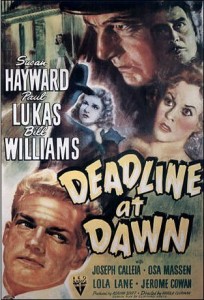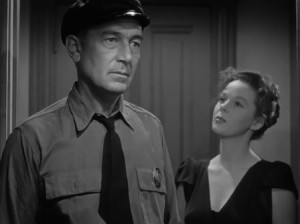There are times when one wonders why we pick the films we look at. When you figure it out, please let us know, as there appears to be little rhyme or reason.
We grabbed an unfamiliar film the other night, 1946’s Deadline at Dawn, directed by Harold Clurman with his only on-screen directing credit. Clurman earned his chops in Broadway and Deadline does run a bit like a play, but not as much as one may expect. Even given some of the rather talky scenes, there is more than enough tension to keep things at a good pace through the short run time.
Deadline at Dawn is a rather forgotten film noir, and perhaps undeservedly so. Among the highlights are a spirited and still very young Susan Hayward, even though she had already done over 20 films by this point. Bill Williams and [intlink id=”942″ type=”category”]Paul Lukas[/intlink] join as well in primary roles as a sailor on leave and a cab driver, respectively. There is also a relatively strong supporting cast, drawn significantly from Clurman’s Broadway contacts.
As it was written by Clifford Odets from an earlier work by Cornell Woolrich, you would expect relatively strong results. Sadly, such is not the case. Much of the dialogue- especially in the first third of the feature, is pedantic, corny, and trite. I have never met folks who talk in this way!
But enough negativity. What exactly is this film about?
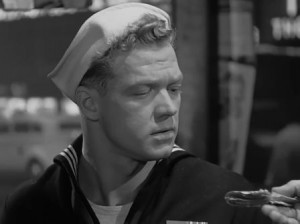 Bill Williams is a sailor on leave who is due to catch a bus at dawn at the end of his leave (hence the title). He awakes after a night of excess with $1,400 in his pocket and vague memories of where it came from, though he remembers being lured to a womans apartment.
Bill Williams is a sailor on leave who is due to catch a bus at dawn at the end of his leave (hence the title). He awakes after a night of excess with $1,400 in his pocket and vague memories of where it came from, though he remembers being lured to a womans apartment.
He meets and ultimately befriends a rather down and out dancer (Susan Hayward) who is skeptical to say the least. After a sandwich at her place she convinces him to return the money, which he does. The only problem is when they do, they realize that the woman has been murdered. But, by whom?
From the start, everyone in the cast, with the exception of Hayward herself, is a suspect. They meet and ultimately befriend a NYC cabbie, played by Paul Lukas, who spouts wisdoms and has the mentality of no cabbie I have ever met- especially in the Big Apple.
But by the end of the picture the ultimate culprit is revealed, though we shan’t delve into it here, should you want to watch this one. Needless to say, there are numerous twists and turns before the murderer is revealed. And as much as I usually figure these things out well in advance, this one presented a real curveball. I went back and there are a few hints as to how things ultimately play out, but you do have to very close attention to catch them.
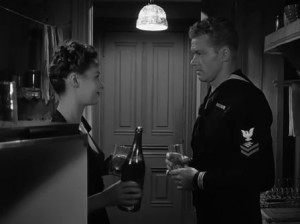 Sadly, to really enjoy this picture, you have to dispense with all sense of reality. When Hayward and Williams discover the murdered woman’s body, they proceed in relatively short order to loot her refrigerator, leaving fingerprints (and presumably crumbs) everywhere. Also, why exactly is Hayward helping this naive and potentially murderous sailor? She’s pretty open about her disdain for men, but yet at the drop of a hat she is helping him. Even more incredulous is the fact that by the end of the film she’s in love with him. Yikes! And remember the entire film happens in the course of one night – perhaps as little as 5-6 hours. For myself, I was born at night, but not last night.
Sadly, to really enjoy this picture, you have to dispense with all sense of reality. When Hayward and Williams discover the murdered woman’s body, they proceed in relatively short order to loot her refrigerator, leaving fingerprints (and presumably crumbs) everywhere. Also, why exactly is Hayward helping this naive and potentially murderous sailor? She’s pretty open about her disdain for men, but yet at the drop of a hat she is helping him. Even more incredulous is the fact that by the end of the film she’s in love with him. Yikes! And remember the entire film happens in the course of one night – perhaps as little as 5-6 hours. For myself, I was born at night, but not last night.
From a visual point of view, Deadline at Dawn fits the definition of noir. Lots of nice shadows and heavy atmosphere. Well done in this regard. As mentioned above, it is rather setbound, but not obtrusively so.
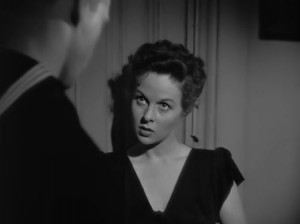 This one came out on standard DVD (gasp!) in 2010 and as of now isn’t available otherwise. While not a great film by any means, Hayward and Lukas make it worth your while. Somewhat hard to find but worth it should you do so.
This one came out on standard DVD (gasp!) in 2010 and as of now isn’t available otherwise. While not a great film by any means, Hayward and Lukas make it worth your while. Somewhat hard to find but worth it should you do so.
